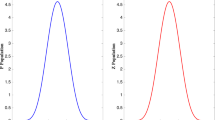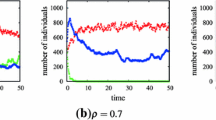Abstract
Evolution takes place in an ecological setting that typically involves interactions with other organisms. To describe such evolution, a structure is needed which incorporates the simultaneous evolution of interacting species. Here a formal framework for this purpose is suggested, extending from the microscopic interactions between individuals — the immediate cause of natural selection, through the mesoscopic population dynamics responsible for driving the replacement of one mutant phenotype by another, to the macroscopic process of phenotypic evolution arising from many such substitutions. The process of coevolution that results from this is illustrated in the context of predator-prey systems. With no more than qualitative information about the evolutionary dynamics, some basic properties of predator-prey coevolution become evident. More detailed understanding requires specification of an evolutionary dynamics; two models for this purpose are outlined, one from our own research on a stochastic process of mutation and selection and the other from quantitative genetics. Much of the interest in coevolution has been to characterize the properties of fixed points at which there is no further phenotypic evolution. Stability analysis of the fixed points of evolutionary dynamical systems is reviewed and leads to conclusions about the asymptotic states of evolution rather different from those of game-theoretic methods. These differences become especially important when evolution involves more than one species.
Similar content being viewed by others
References
Abrams, P. A.: Is predator-prey coevolution an arms race? Trends Ecol. Evol.1, 108–110 (1986)
Abrams, P. A.: The importance of intraspecific frequency-dependent selection in modelling competitive coevolution. Evol. Ecol.3, 215–220 (1989)
Abrams, P. A., Matsuda, H., Harada, Y.: Evolutionarily unstable fitness maxima and stable fitness minima of continuous traits. Evol. Ecol.7, 465–487 (1993)
Anderson, P. A., May, R. M.: Coevolution of hosts and parasites. Parasitology85, 411–426 (1982)
Bakker, R. T.: The deer flees, the wolf pursues: incongruencies in predator-prey coevolution. In: Futuyma, D. J., Slatkin, M. (eds.) Coevolution, pp. 350–382. Sunderland Massachusetts: Sinauer Associates 1983
Brown, J. S., Vincent, T. L.: Coevolution as an evolutionary game. Evolution41, 66–79 (1987a)
Brown, J. S., Vincent, T. L.: Fredator-prey coevolution as an evolutionary game. In: Cohen, Y. (ed.) Applications of Control Theory in Ecology, pp. 83–101. Lecture Notes in Biomathematics 73. Berlin: Springer Verlag 1987b
Brown, J. S., Vincent, T. L.: Organization of predatorprey communities as an evolutionary game. Evolution46, 1269–1283 (1992)
Carroll, L.: Through the Looking Glass and what Alice found there. London: Macmillan 1871 (Harmondsworth Middlesex: Penguin Books 1970)
Christiansen, F. B.: On conditions for evolutionary stability for a continuously varying character. Amer. Natur.138, 37–50 (1991)
Darwin, C.: The Origin of Species by Means of Natural Selection. John Murray 1859 (Harmondsworth Middlesex: Penguin Books 1968)
Dawkins, R., Krebs, J. R.: Arms races between and within species. Proc. R. Soc. Lond. B205, 489–511 (1979)
Dieckmann, U.: Coevolutionary dynamics of stochastic replicator systems. Berichte des Forschungszentrums Jülich, 3018, Jülich Germany 1994
Dieckmann, U., Law, R.: The dynamical theory of coevolution: a derivation from stochastic ecological processes. J. Math. Biol.34, 579–612 (1996)
Dieckmann, U., Marrow, P., Law, R.: Evolutionary cycling in predator-prey interactions: population dynamics and the Red Queen. J. Theor. Biol.176, 91–102 (1995)
Dwyer, G., Levin, S. A., Buttel, L.: A simulation model of the poulation dynamics and evolution of myxomatosis. Ecol. Monogr.60, 423–447 (1990)
Edley, M. E., Law, R.: Evolution of life histories and yields in experimental populations ofDaphnia magna. Biol. J. Linn. Soc.34, 309–326 (1988)
Ehrlich, P. R., Raven, P. H.: Butterflies and plants: a study in coevolution. Evolution18, 586–608 (1964)
Eshel, I.: Evolutionary and continuous stability. J. theor. Biol.103, 99–111 (1983)
Eshel, I., Motro, U.: Kin selection and strong evolutionary stability of mutual help. Theor. Pop. Biol.19, 420–433. (1981)
Falconer, D. S.: Introduction to Quantitative Genetics. 3rd Edition. Harlow: Longman 1989
Fenner, F., Ratcliffe, F. N.: Myxomatosis. Cambridge University Press 1965
Fisher, R. A.: The Genetical Theory of Natural Selection. 2nd Edition. New York: Dover Publications 1958
Futuyma, D. J., Slatkin, M.: Introduction. In: Futuyma, D. J., Slatkin, M. (eds.) Coevolution, pp. 1–13. Sunderland Massachusetts: Sinauer Associates 1983
Gatto, M.: The evolutionary optimality of oscillatory and chaotic dynamics in simple population models. Theor. Pop. Biol.43, 310–336 (1993)
Godfray, H. C. J., Cook, L. M., Hassell, M. P.: Population dynamics, natural selection and chaos. In: Berry, R. J., Crawford, T. J., Hewitt, G. M. (eds) Genes in ecology, pp 55–86. Oxford: Blackwell Scientific Publications (1993)
Hansen, T. F.: Evolution of stability parameters in single-species population models: stability or chaos? Theor. Pop. Biol.42, 199–217 (1992)
Harrison, G. W.: Global stability of food chains. Amer. Natur.114, 455–457 (1979)
Hassell, M. P., Lawton, J. H., May, R. M.: Patterns of dynamical behaviour in single-species populations. J. Anim. Ecol.45, 471–486 (1976)
Hofbauer, J., Sigmund, K.: Adaptive dynamics and evolutionary stability. Appl. Math. Lett.3, 75–79 (1990)
Hutchinson, G. E.: The Ecological Theater and the Evolutionary Play. New Haven Connecticutt: Yale University Press 1967
Iwasa, Y., Pomiankowski, A., Nee, S.: The evolution of costly mate preferences. II. The “handicap” principle. Evolution45, 1431–1442 (1991)
Janzen, D. H.: When is it coevolution? Evolution34, 611–612 (1980)
Jayakar, S. D., Zonta L. A.: Coevolution at two trophic levels. In: Wöhrmann, K., Jain, S. K. (eds) Population Biology, pp. 349–366. Berlin: Springer Verlag 1990
Kauffman, S. A.: The Origins of Order: Self-Organization and Selection in Evolution. New York: Oxford University Press 1993
Kauffman, S. A., Johnsen, S.: Coevolution to the edge of chaos: coupled fitness landscapes, poised states, and coevolutionary avalanches. J. theor Biol.149, 467–505 (1991)
Kitchell, J. A., Boggs, C. H., Kitchell, J. F., Rice, J. A.: Prey selection by natacid gastropods: experimental tests and application to the fossil record. Palaeobiology7, 533–552 (1981)
Lande, R.: Quantitative genetic analysis of multivariate evolution, applied to brain:body size allometry. Evolution33, 402–416 (1979)
Levin, S. A., Segel, L. A., Adler, F. R.: Diffuse coevolution in plant-herbivore communities. Theor. Pop. Biol.37, 171–191 (1990)
Lewontin, R. C.: Fitness, survival, and optimality. In: Horn, D. J., Stairs, G. R., Mitchell, R. D. (eds.) Analysis of Ecological Systems, pp. 3–21. Ohio State University Press 1979
Marrow, P., Law, R., Cannings, C.: The coevolution of predator-prey interactions: ESSs and Red Queen dynamics. Proc. R. Soc. Lond. B250, 133–141 (1992)
Marrow, P., Cannings, C.: Evolutionary instability in predator-prey systems. J. theor. Biol.160, 135–150 (1993)
Mather, K.: Genetical Structure of Populations. London: Chapman and Hall 1973
Maynard Smith, J.: A comment on the Red Queen. Amer. Natur.110, 325–330 (1976)
Maynard Smith, J.: Evolution and the Theory of Games. Cambridge University Press 1982
Maynard Smith, J., Price, G. R.: The logic of animal conflict. Nature Lond.246, 15–18 (1973)
Metz, J. A. J., Nisbet, R. M., Geritz, S. A. H.: How should we define ‘fitness’ for general ecological scenarios? Trends Ecol. Evol.7, 198–202 (1992)
Metz, J. A. J, Geritz, S. A. H., Iwasa, Y: On the dynamical classification of evolutionarily singular strategies. University of Leiden Preprint, Leiden, The Netherlands (1994)
Michod, R. E.: Evolution of life histories in response to age-specific mortality factors. Amer. Natur.113, 531–550 (1979)
Parker, G. A.: Arms races in evolution — an ESS to the opponent-independent costs game. J. theor. Biol.101, 619–648 (1983)
Parker, G. A.: Population consequences of evolutionarily stable strategies. In: Sibly, R. M., Smith, R. H. (eds) Behavioural Ecology: Ecological Consequences of Adaptive Behaviour, pp 33–57. Oxford: Blackwell Scientific 1985
Parker, G. A., Maynard Smith, J.: Optimality theory in evolutionary biology. Nature Lond. 348, 27–33 (1990)
Pimentel, D.: Population regulation and genetic feedback. Science 159, 1432–1437 (1968)
Pimm, S. L., Lawton, J. H., Cohen, J. E.: Food web patterns and their consquences. Nature, Lond.350, 669–674 (1991)
Rand, D. A., Wilson, H. B.: Chaotic stochasticity: a ubiquitous source of unpredictability in epidemics. Proc. Roy. Soc. Lond. B246, 179–184 (1991)
Reed, J., Stenseth, N. C.: On evolutionarily stable strategies. J. theor. Biol.108, 491–508 (1984)
Rosenzweig, M. L.: Evolution of the predator isocline. Evolution27, 84–94 (1973)
Rosenzweig, M. L., Brown, J. S., Vincent, T. L.: Red Queens and ESS: the coevolution of evolutionary rates. Evol. Ecol.1, 59–94 (1987)
Roughgarden, J.: Theory of population genetics and evolutionary ecology: an introduction. New York: Macmillan 1979.
Roughgarden, J.: The theory of coevolution. In: Futuyma, D. J., Slatkin, M. (eds) Coevolution, pp. 33–64. Sunderland Massachusetts: Sinauer Associates 1983.
Roughgarden, J.: Community coevolution: a comment. Evolution41, 1130–1134 (1987)
Saloniemi, I.: A coevolutionary predator-prey model with quantitative characters. Amer. Natur.141, 880–896 (1993)
Slatkin, M., Maynard Smith, J.: Models of coevolution. Q. Rev. Biol.54, 233–263 (1979)
Slobodkin, L. B.: How to be a predator. Amer. Zool.8, 43–51 (1968)
Slobodkin, L. B.: Prudent predation does not require group selection. Amer. Natur.108, 665–678 (1974)
Stanley, S. M., Van Valkenburg, B., Steneck, R. S.: Coevolution and the fossil record. In: Futuyma, D. J., Slatkin, M. (eds.) Coevolution, pp. 328–349. Sunderland Massachusetts: Sinauer Associates 1983
Stenseth, N. C.: Darwinian evolution in ecosystems: a survey of some ideas and difficulties together with some possible solutions. In: Castri, J. L., Karlquist, A. (eds) Complexity, language and life: mathematical approaches, pp 105–145. Berlin: Springer-Verlag 1986
Stenseth, N. C., Maynard Smith, J.: Coevolution in ecosystems: Red Queen evolution or stasis? Evolution38, 870–880 (1984)
Stokes, T. K., Gurney, W. S. C., Nisbet, R. M., Blythe, S. P.: Parameter evolution in a laboratory insect population. Theor. Pop. Biol.34, 248–265 (1988)
Takada, T., Kigami, J.: The dynamical attainability of ESS in evolutionary games. J. Math. Biol.29, 513–529 (1991)
Taper, M. L., Case, T. J.: Models of character displacement and the theoretical robustness of taxon cycles. Evolution46, 317–333 (1992)
Taylor, P. D.: Evolutionary stability in one-parameter models under weak selection. Theor. Pop. Biol.36, 125–143 (1989)
Turchin, P., Taylor, A. D.: Complex dynamics in ecological time series. Ecology73, 289–305 (1992)
van Kampen, N. G.: Stochastic processes in physics and chemistry. Amsterdam: North Holland 1981
Van Valen, L.: A new evolutionary law. Evol. Theory1, 1–30 (1973)
Vermeij, G. J.: Unsuccessful predation and evolution. Amer. Natur.120, 701–720 (1982)
Vermeij, G. J.: Intimate associations and coevolution in the sea. In: Futuyma, D. J., Slatkin, M. (eds.) Coevolution, pp. 311–327. Sunderland Massachusetts: Sinauer Associates 1983
Vermeij, G. J.: Evolution and escalation: an ecological history of life. Princeton New Jersey: Princeton University Press 1987
Vermeij, G. J., Covitch, A. P.: Coevolution of freshwater gastropods and their predators. Amer. Natur.112, 833–843 (1978)
Vincent, T. L.: Strategy dynamics and the ESS. In: Vincent, T. L., Mees, A. I., Jennings, L. S. (eds.) Dynamics of Complex Interconnected Biological Systems, pp. 236–262. Basel: Birkhäuser 1991
West, K., Cohen, A., Baron, M.: Morphology and behaviour of crabs and gastropods from Lake Tanganyika, Africa: impllications for lacustrine predator-prey coevolution. Evolution45, 589–607 (1991)
Author information
Authors and Affiliations
Rights and permissions
About this article
Cite this article
Marrow, P., Dieckmann, U. & Law, R. Evolutionary dynamics of predator-prey systems: an ecological perspective. J. Math. Biology 34, 556–578 (1996). https://doi.org/10.1007/BF02409750
Received:
Revised:
Issue Date:
DOI: https://doi.org/10.1007/BF02409750




